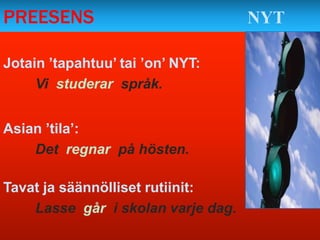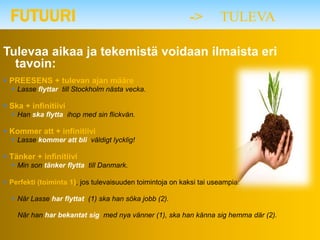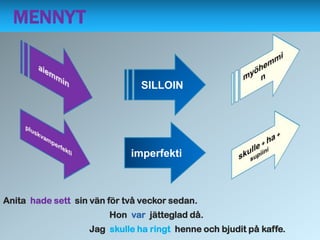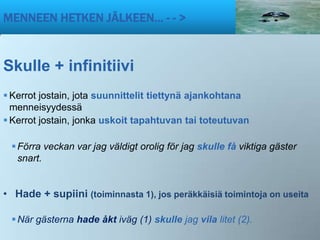1 of 11



![PERFEKTI
HAR + SUPIINI
Ilmaisee jotain, joka on tapahtunut ennen NYT-hetke├ż
’é¦ Anita har l├żst alla b├Čcker av Henning Mankell.
[Kirjat on luettu; emme tarkkaan tied├ż milloin]
Mukana voi olla aikailmaus, joka jatkuu - - -
’é¦ Jag har druckit te i dag.
[Tee on juotu, mutta p├żiv├ż jatkuuŌĆ”]
Kerrot, ŌĆÖkuinka kauanŌĆÖ (ajanjakso) joku on tehnyt jotakin
’é¦ Stina har jobbat p├ź Ikea sedan 1989.
[Aloitti vuonna 1989; jatkaa siell├ż edelleen]](https://image.slidesharecdn.com/ruotsalainenaika2-111108113040-phpapp01/85/Ruotsalainen-aika-4-320.jpg)


![ŌĆÖSILLOINŌĆÖ
Jotain on tapahtunut tiettyn├ż hetken├ż:
ŌĆÖSILLOINŌĆÖ
’é¦ Sek├ż toiminta ett├ż ajankohta ovat mennytt├ż (ohi)
’é¦ Jag l├żste boken till klockan 6 p├ź kv├żllen i g├źr.
[en lue en├ż├ż, eik├ż en├ż├ż ole eilinen]](https://image.slidesharecdn.com/ruotsalainenaika2-111108113040-phpapp01/85/Ruotsalainen-aika-7-320.jpg)
![PLUSKVAMPERFEKTI ’ā¤ ŌĆÖF├¢RE D├ģŌĆÖ
Jotain tapahtui
ennen tietty├ż hetke├ż
menneisyydess├ż
N├żr jag hade ├żtit tog jag bussen hem
[ensin s├Čin, sitten l├żhdin bussilla kotiin]](https://image.slidesharecdn.com/ruotsalainenaika2-111108113040-phpapp01/85/Ruotsalainen-aika-8-320.jpg)



Ad
Recommended
Cohesion: Reference Words
Cohesion: Reference Wordslcslidepresentations
╠²
Reference words are used to avoid repeating words and refer back to people, objects, or ideas mentioned earlier or refer forward to those mentioned later. Common reference words include it/they/them, this/that/these/those, the former/the latter, who/which/that, one/ones, and such. These reference words help writers streamline their writing and prevent redundancy.Verbin aikamuodot (uusi versio 2021)
Verbin aikamuodot (uusi versio 2021)Anna-Maria Kohtala
╠²
Suomen kielen ja englannin kielen vertailu aikamuodoista.
Aikamuodot: preesens, imperfekti, perfekti ja pluskvaP├ż├żlauseen sanaj├żrjestys
P├ż├żlauseen sanaj├żrjestyshiljadesign
╠²
T├żss├ż esityksess├ż kerrataan ruotsin kielen p├ż├żlauseen suora ja k├ż├żnteinen sanaj├żrjestys. Esitys on tehty osaksi lukion verkko-opetusta ja tarinana etenev├ż├ż ruotsin kielen tukikurssia Diakonia-ammattikorkeakoulussa vuonna 2014. Esitykseen liittyy my├Čs videotallenne, jonka avulla voi helpommin itsen├żisesti kerrata power pointin asioita.Simple future tense and future continuous
Simple future tense and future continuousDwi Putra Mahardhika
╠²
The document discusses the simple future tense and be going to future in English. It provides examples of how to form sentences using will for spontaneous or predicted future actions, and be going to for planned future intentions. Patterns given include subject + will + verb and subject + be + going + to + verb. Examples are provided such as "I will open the door" and "You are going to meet Jane tonight". Time expressions that can be used with simple future are also listed from tomorrow to three days later.Present indefinite tense definition
Present indefinite tense definitionEnglish Summary
╠²
This document discusses the present indefinite tense in English grammar. The present indefinite tense is used for actions or events that occur in the present or current time, but continue for an indefinite or unknown period of time. It provides examples of using the first form of verbs with pronouns like he, she, it, I, we, you, they and adding -s or -es to verbs used with he, she, it and nouns.Time clause and conditional
Time clause and conditionalmacbridesmith
╠²
This document discusses time clauses and conditionals. It defines time clauses as adverb clauses beginning with time words that describe when something occurs. It also explains the first conditional, which uses "if" with the present tense to describe possible real events, and the second conditional, which uses "if" with the past tense to describe hypothetical or imaginary events. Examples are provided for both types of conditionals. The document concludes with a brief grammar review of these structures.Present perfect tense
Present perfect tenseReyfel Tortolero
╠²
This document discusses the present perfect tense in English. It provides examples of sentences in the present perfect tense and explains its structure. Specifically, it uses the formula Subject + have/has + past participle. It also discusses the use of already, just and yet with the present perfect tense to indicate the timing of actions.Past simple indefinite tense
Past simple indefinite tenseKolevatovaTY
╠²
This document provides instruction on using the past simple tense in English. It discusses regular and irregular verbs in the past tense. Examples are given of asking questions and making negatives using auxiliary verbs like "did" and "was/were". Common questions are modeled like "What did you do yesterday?" Practice questions are also provided for students to form their own questions in the past simple tense.Scrum vs Kanban
Scrum vs KanbanJaladhi Bhatt
╠²
Scrum and Kanban are both agile project management methodologies. Scrum uses fixed length sprints to complete work in iterations, while Kanban uses a continuous flow approach. Some key differences are that Scrum requires timeboxing, estimation, and specific roles while Kanban is more flexible and focuses on limiting work in progress. Both aim to deliver work continuously and accommodate changes, with Scrum better for new products and Kanban for repetitive tasks. Metrics also differ, with Scrum using velocity and Kanban using lead time to measure delivery.Present perfect continuous / present perfect progressive
Present perfect continuous / present perfect progressive junaid Iqbal
╠²
The document explains the structure and usage of the present perfect continuous tense, detailing its formation with examples. It highlights two primary uses: actions that have recently stopped and actions that continue to the present, often including the terms 'for' and 'since.' Additionally, the document provides practice exercises to reinforce understanding of the tense.I tempi verbali della grammatica inglese
I tempi verbali della grammatica inglese2aafmoriani
╠²
Il documento descrive i principali tempi verbali della grammatica inglese, tra cui il present simple, present continuous, simple past, present perfect, present perfect continuous e il futuro, spiegandone l'uso, la formazione e le differenze. Viene fornita un'analisi delle espressioni temporali e delle costruzioni specifiche per ciascun tempo, nonch├® le diverse sfumature di obbligo con 'must' e 'have to'. Infine, il documento menziona le condizioni e i modelli per esprimere probabilit├Ā e capacit├Ā.Past tenses
Past tensesAna Sancho
╠²
The document details the formation and usage of various past tenses in English, including the simple past, past continuous, past perfect, and past perfect continuous. It provides rules for verb conjugation, examples of each tense, and specific time expressions associated with their use. The document is a grammar resource aimed at helping learners understand the nuances of past tense usage.Simple future tense
Simple future tenseFlorizqul Shodiq
╠²
The document discusses the simple future tense in English. It explains that there are two forms: "will" and "be going to." While sometimes interchangeable, they often express different meanings. "Will" is used to express voluntary actions, promises, and predictions. "Be going to" expresses plans and can also be used for predictions. The simple future tense follows a subject + auxiliary verb + main verb structure. Examples are provided to illustrate the different uses and forms of the simple future tense.Trip to the Zoo
Trip to the Zooamandaluteran
╠²
This document contains a summary of a child's visit to the zoo, highlighting facts in yellow and opinions in blue. The summary includes observations about elephants, monkeys, birds like bald eagles and hummingbirds, and different species of bears such as pandas and polar bears. The document concludes with statements about reptiles like Komodo dragons and snakes, and expresses the opinion that the zoo was a fun experience.When while
When whileHilmi Y─▒lmaz
╠²
The document contrasts long actions (actions that take time or are ongoing) and short actions (instantaneous or brief actions) in English. It then discusses the use of "when" with short past actions and "while" with long past continuous actions. Some examples are provided to illustrate how to use "when" and "while" in sentences, including with both simple past and past continuous verb tenses.Idioms related to work and jobs
Idioms related to work and jobs▓č├Ł░∙Š▒▓╣│Š
╠²
This document provides definitions and examples of common idioms related to work and jobs:
- "Beaver away at something" means to work hard for a long time.
- "Keep one's mind on the job" means to give all one's attention to the task at hand.
- "To mean business" means to be very serious about something.
- "Make ends meet" refers to earning and spending equal amounts of money, usually just enough for basic living expenses.Adjektiivit, ruotsin kieli
Adjektiivit, ruotsin kielihiljadesign
╠²
T├żss├ż esityksess├ż kerrataan ruotsin kielen adjektiivit. Esitys on tehty osaksi lukion verkko-opetusta ja tarinana etenev├ż├ż ruotsin kielen tukikurssia Diakonia-ammattikorkeakoulussa vuonna 2014. Esitykseen liittyy my├Čs varsinaisella kurssilla videotallenne, jonka avulla voi helpommin itsen├żisesti kerrata power pointin asioita.DATES IN ENGLISH.pptx
DATES IN ENGLISH.pptxYiyi Portilla
╠²
This document provides information about writing dates in the British and American formats, including the days of the week, months of the year, and seasons. It explains that in the British format, the date is written with the day of the week followed by the day number in ordinal form, the month, and then the full four-digit year. In the American format, the date is written with the day of the week followed by the month, the day number in ordinal form, and then the full four-digit year. The document also gives some practice examples of writing dates in both formats.The subjunctive mood
The subjunctive moodcoolsimo
╠²
The document discusses the subjunctive mood in English grammar. It describes the two forms of the subjunctive as synthetic and analytic. The synthetic subjunctive has present and past tense forms, while the analytic subjunctive uses modal verbs like shall, should, would, may, might, and could followed by an infinitive. It provides examples of how the different forms of the subjunctive are used in various clause types like conditional clauses, subject clauses, and purpose clauses.Phrase, clause, and sentence
Phrase, clause, and sentenceRestu Mustaqim
╠²
The document discusses various grammatical concepts including phrases, clauses, and sentence structure. It defines phrases as groups of words without a subject and verb, and identifies 8 types of phrases including noun, verb, adjective, and prepositional phrases. Clauses are defined as having a subject and verb and can be independent or dependent. Sentences are composed of clauses and their structure involves subjects, verbs, and 6 patterns including noun-verb and noun-verb-noun patterns. The document also contrasts simple versus complex sentences.Present Perfect Simple vs Continuous
Present Perfect Simple vs ContinuousMissflorpm
╠²
The document discusses the difference between the present perfect and present perfect continuous tenses. The present perfect is used to talk about completed actions or events that have a connection to the present. The present perfect continuous focuses on unfinished or ongoing actions and events and how long they have been occurring. Some verbs like "live", "work", and "study" can be used with both tenses without a difference in meaning. The present perfect is used with time expressions like "for", "since", "already", and "yet". The present perfect continuous is used with expressions like "for", "since", "how long", "lately", and "recently".An informal email
An informal emailNuria de Salvador
╠²
This document provides guidance on writing informal emails and letters. It recommends using openings like "Hi" or the recipient's name to start, and suggests using exclamation points sparingly to show strong feelings. Contractions are normally used in emails to friends, but not in formal emails. When starting an email with "Hi" followed by a name, a comma comes after the name, not "Hi". Paragraphs require a single space, not a double space. The document also provides examples of common phrases for different parts of emails, such as starting, providing good or bad news, moving the topic, making requests, and ending the email.Present perfect simple & Present Perfect Continuous
Present perfect simple & Present Perfect ContinuousSylwia Angielski
╠²
Present perfect simple & Present Perfect ContinuousOpintojakso lukion 1.vuosikurssin oppilaille
Opintojakso lukion 1.vuosikurssin oppilailleaiski92
╠²
Opintojakso lukion 1.vuosikurssin oppilaille, jonka p├ż├żteemoima ovat matkustaminen ja kielioppiasiana konditionaali. Opintojaksomme koostuu kahdesta 75 minuutin oppitunnista, jotka sis├żlt├żv├żt monipuolisesti erilaisten sovellusten k├żytt├Č├ż, kuten Pinterest, Popplet, Muppet Show ja Socrative.More Related Content
What's hot (20)
Time clause and conditional
Time clause and conditionalmacbridesmith
╠²
This document discusses time clauses and conditionals. It defines time clauses as adverb clauses beginning with time words that describe when something occurs. It also explains the first conditional, which uses "if" with the present tense to describe possible real events, and the second conditional, which uses "if" with the past tense to describe hypothetical or imaginary events. Examples are provided for both types of conditionals. The document concludes with a brief grammar review of these structures.Present perfect tense
Present perfect tenseReyfel Tortolero
╠²
This document discusses the present perfect tense in English. It provides examples of sentences in the present perfect tense and explains its structure. Specifically, it uses the formula Subject + have/has + past participle. It also discusses the use of already, just and yet with the present perfect tense to indicate the timing of actions.Past simple indefinite tense
Past simple indefinite tenseKolevatovaTY
╠²
This document provides instruction on using the past simple tense in English. It discusses regular and irregular verbs in the past tense. Examples are given of asking questions and making negatives using auxiliary verbs like "did" and "was/were". Common questions are modeled like "What did you do yesterday?" Practice questions are also provided for students to form their own questions in the past simple tense.Scrum vs Kanban
Scrum vs KanbanJaladhi Bhatt
╠²
Scrum and Kanban are both agile project management methodologies. Scrum uses fixed length sprints to complete work in iterations, while Kanban uses a continuous flow approach. Some key differences are that Scrum requires timeboxing, estimation, and specific roles while Kanban is more flexible and focuses on limiting work in progress. Both aim to deliver work continuously and accommodate changes, with Scrum better for new products and Kanban for repetitive tasks. Metrics also differ, with Scrum using velocity and Kanban using lead time to measure delivery.Present perfect continuous / present perfect progressive
Present perfect continuous / present perfect progressive junaid Iqbal
╠²
The document explains the structure and usage of the present perfect continuous tense, detailing its formation with examples. It highlights two primary uses: actions that have recently stopped and actions that continue to the present, often including the terms 'for' and 'since.' Additionally, the document provides practice exercises to reinforce understanding of the tense.I tempi verbali della grammatica inglese
I tempi verbali della grammatica inglese2aafmoriani
╠²
Il documento descrive i principali tempi verbali della grammatica inglese, tra cui il present simple, present continuous, simple past, present perfect, present perfect continuous e il futuro, spiegandone l'uso, la formazione e le differenze. Viene fornita un'analisi delle espressioni temporali e delle costruzioni specifiche per ciascun tempo, nonch├® le diverse sfumature di obbligo con 'must' e 'have to'. Infine, il documento menziona le condizioni e i modelli per esprimere probabilit├Ā e capacit├Ā.Past tenses
Past tensesAna Sancho
╠²
The document details the formation and usage of various past tenses in English, including the simple past, past continuous, past perfect, and past perfect continuous. It provides rules for verb conjugation, examples of each tense, and specific time expressions associated with their use. The document is a grammar resource aimed at helping learners understand the nuances of past tense usage.Simple future tense
Simple future tenseFlorizqul Shodiq
╠²
The document discusses the simple future tense in English. It explains that there are two forms: "will" and "be going to." While sometimes interchangeable, they often express different meanings. "Will" is used to express voluntary actions, promises, and predictions. "Be going to" expresses plans and can also be used for predictions. The simple future tense follows a subject + auxiliary verb + main verb structure. Examples are provided to illustrate the different uses and forms of the simple future tense.Trip to the Zoo
Trip to the Zooamandaluteran
╠²
This document contains a summary of a child's visit to the zoo, highlighting facts in yellow and opinions in blue. The summary includes observations about elephants, monkeys, birds like bald eagles and hummingbirds, and different species of bears such as pandas and polar bears. The document concludes with statements about reptiles like Komodo dragons and snakes, and expresses the opinion that the zoo was a fun experience.When while
When whileHilmi Y─▒lmaz
╠²
The document contrasts long actions (actions that take time or are ongoing) and short actions (instantaneous or brief actions) in English. It then discusses the use of "when" with short past actions and "while" with long past continuous actions. Some examples are provided to illustrate how to use "when" and "while" in sentences, including with both simple past and past continuous verb tenses.Idioms related to work and jobs
Idioms related to work and jobs▓č├Ł░∙Š▒▓╣│Š
╠²
This document provides definitions and examples of common idioms related to work and jobs:
- "Beaver away at something" means to work hard for a long time.
- "Keep one's mind on the job" means to give all one's attention to the task at hand.
- "To mean business" means to be very serious about something.
- "Make ends meet" refers to earning and spending equal amounts of money, usually just enough for basic living expenses.Adjektiivit, ruotsin kieli
Adjektiivit, ruotsin kielihiljadesign
╠²
T├żss├ż esityksess├ż kerrataan ruotsin kielen adjektiivit. Esitys on tehty osaksi lukion verkko-opetusta ja tarinana etenev├ż├ż ruotsin kielen tukikurssia Diakonia-ammattikorkeakoulussa vuonna 2014. Esitykseen liittyy my├Čs varsinaisella kurssilla videotallenne, jonka avulla voi helpommin itsen├żisesti kerrata power pointin asioita.DATES IN ENGLISH.pptx
DATES IN ENGLISH.pptxYiyi Portilla
╠²
This document provides information about writing dates in the British and American formats, including the days of the week, months of the year, and seasons. It explains that in the British format, the date is written with the day of the week followed by the day number in ordinal form, the month, and then the full four-digit year. In the American format, the date is written with the day of the week followed by the month, the day number in ordinal form, and then the full four-digit year. The document also gives some practice examples of writing dates in both formats.The subjunctive mood
The subjunctive moodcoolsimo
╠²
The document discusses the subjunctive mood in English grammar. It describes the two forms of the subjunctive as synthetic and analytic. The synthetic subjunctive has present and past tense forms, while the analytic subjunctive uses modal verbs like shall, should, would, may, might, and could followed by an infinitive. It provides examples of how the different forms of the subjunctive are used in various clause types like conditional clauses, subject clauses, and purpose clauses.Phrase, clause, and sentence
Phrase, clause, and sentenceRestu Mustaqim
╠²
The document discusses various grammatical concepts including phrases, clauses, and sentence structure. It defines phrases as groups of words without a subject and verb, and identifies 8 types of phrases including noun, verb, adjective, and prepositional phrases. Clauses are defined as having a subject and verb and can be independent or dependent. Sentences are composed of clauses and their structure involves subjects, verbs, and 6 patterns including noun-verb and noun-verb-noun patterns. The document also contrasts simple versus complex sentences.Present Perfect Simple vs Continuous
Present Perfect Simple vs ContinuousMissflorpm
╠²
The document discusses the difference between the present perfect and present perfect continuous tenses. The present perfect is used to talk about completed actions or events that have a connection to the present. The present perfect continuous focuses on unfinished or ongoing actions and events and how long they have been occurring. Some verbs like "live", "work", and "study" can be used with both tenses without a difference in meaning. The present perfect is used with time expressions like "for", "since", "already", and "yet". The present perfect continuous is used with expressions like "for", "since", "how long", "lately", and "recently".An informal email
An informal emailNuria de Salvador
╠²
This document provides guidance on writing informal emails and letters. It recommends using openings like "Hi" or the recipient's name to start, and suggests using exclamation points sparingly to show strong feelings. Contractions are normally used in emails to friends, but not in formal emails. When starting an email with "Hi" followed by a name, a comma comes after the name, not "Hi". Paragraphs require a single space, not a double space. The document also provides examples of common phrases for different parts of emails, such as starting, providing good or bad news, moving the topic, making requests, and ending the email.Present perfect simple & Present Perfect Continuous
Present perfect simple & Present Perfect ContinuousSylwia Angielski
╠²
Present perfect simple & Present Perfect ContinuousViewers also liked (8)
Opintojakso lukion 1.vuosikurssin oppilaille
Opintojakso lukion 1.vuosikurssin oppilailleaiski92
╠²
Opintojakso lukion 1.vuosikurssin oppilaille, jonka p├ż├żteemoima ovat matkustaminen ja kielioppiasiana konditionaali. Opintojaksomme koostuu kahdesta 75 minuutin oppitunnista, jotka sis├żlt├żv├żt monipuolisesti erilaisten sovellusten k├żytt├Č├ż, kuten Pinterest, Popplet, Muppet Show ja Socrative.Ad
More from Ritva Tammi (20)
Expressing your opinions
Expressing your opinionsRitva Tammi
╠²
This document provides suggestions for expressing personal opinions and general opinions. When expressing a personal opinion, use phrases like "in my opinion" or "as I see it." Provide reasons and evidence to support your personal view. When expressing a general opinion, avoid absolute statements and attribute the view to "some people" or "most people." Provide details to back up the general opinion. You can agree or disagree with others' opinions as long as you have reasons for your own view. The document encourages respectful discussion and exchange of different perspectives.What makes finnish so finnish
What makes finnish so finnishRitva Tammi
╠²
Finnish has several distinctive features that make its language and pronunciation unique:
1) Gemination, where the first consonant of the following word is doubled if it begins with a vowel.
2) Long and short vowels that impact pronunciation and meaning.
3) Consonant gradation where consonants like K, P, and T change form depending on suffixes added.
4) A complex system of stems, suffixes, endings and cases that determine verbs, nouns and their relationships in sentences.Harjoittele suomen puhekielt├ż
Harjoittele suomen puhekielt├żRitva Tammi
╠²
The document provides examples of spoken Finnish language used in various everyday situations and contexts. It includes common phrases, verbs, pronouns and questions used for introducing oneself, asking for and giving information, making requests, discussing present and past events, needs, activities, locations and travel plans. The document is intended to help learners practice and familiarize themselves with colloquial spoken Finnish.Runebergin tortut
Runebergin tortutRitva Tammi
╠²
Johan Ludvig Runeberg was a Finnish poet celebrated on Runeberg Day each February 5th by eating Runberg Cakes. The document provides a recipe for Runberg Cakes in Finnish, including instructions for making the dough, baking the muffins, and decorating them with raspberry jam and icing sugar. It notes that Runeberg apparently enjoyed these cakes, and that his wife Fredrika, herself a writer and pioneer for women in journalism, was originally known for baking the cakes that bear their name.Tulkaa k├żym├ż├żn!
Tulkaa k├żym├ż├żn!Ritva Tammi
╠²
This document provides information about Finnish housing and living customs. It describes common house types like detached houses (omakotitalo), apartments of different sizes (yksio, kaksio, kolmio), and buildings with multiple apartments. It discusses housebuilding traditions like talkoot where neighbors help each other. It also covers housewarming party etiquette like bringing salt and bread as a gift and taking shoes off inside. Overall, the document aims to teach English learners vocabulary and expressions related to Finnish homes, invitations, and social interactions.The genitive
The genitiveRitva Tammi
╠²
The document discusses the genitive case in Finnish. It notes that the ending of the singular genitive is -n. It is used to express possession like in English. The stem form without the -n ending is needed to form other cases in Finnish. It also discusses consonant changes that occur in different cases, like t becoming d, and provides examples like katu becoming kadun in the genitive case. It includes a table showing the main consonant changes that are integral to the Finnish language.Suomalainen vapaa aika
Suomalainen vapaa aikaRitva Tammi
╠²
Finns enjoy reading, using libraries, and newspapers. They also enjoy social media, television, radio, and a variety of musical genres. Popular outdoor activities include ice hockey, baseball, skiing, cycling, and visiting saunas. Open-air dances are a part of Finnish culture where people gather to socialize and experience music and potential romance. Nature is an important part of Finnish life and culture.Lounaalla
LounaallaRitva Tammi
╠²
This document provides vocabulary and phrases for talking about food and ordering in a restaurant in Finnish. It includes words for common foods, meals, drinks and dishes. Phrases are presented for having a conversation with a waiter at a restaurant where you can ask questions about the menu options and place an order. Specific foods that are highlighted include salmon, potato mash, mineral water, ice cream and coffee.Ad
Recently uploaded (20)
Culture Renovation: 18 Leadership Actions to Build an Unshakeable Company Kev...
Culture Renovation: 18 Leadership Actions to Build an Unshakeable Company Kev...mwlwghg5137
╠²
Culture Renovation: 18 Leadership Actions to Build an Unshakeable Company Kevin Oakes
Culture Renovation: 18 Leadership Actions to Build an Unshakeable Company Kevin Oakes
Culture Renovation: 18 Leadership Actions to Build an Unshakeable Company Kevin OakesHealth systems science Second Edition. Edition Jeffrey M. Borkan (Editor)
Health systems science Second Edition. Edition Jeffrey M. Borkan (Editor)kakzzmxm4272
╠²
Health systems science Second Edition. Edition Jeffrey M. Borkan (Editor)
Health systems science Second Edition. Edition Jeffrey M. Borkan (Editor)
Health systems science Second Edition. Edition Jeffrey M. Borkan (Editor)Estudios de evaluaci├│n de competencia de la OCDE M├®xico Coll.
Estudios de evaluaci├│n de competencia de la OCDE M├®xico Coll.wouuchiu0578
╠²
Estudios de evaluaci├│n de competencia de la OCDE M├®xico Coll.
Estudios de evaluaci├│n de competencia de la OCDE M├®xico Coll.
Estudios de evaluaci├│n de competencia de la OCDE M├®xico Coll.Indoeuropean Linguistics Michael Meierbrgger
Indoeuropean Linguistics Michael Meierbrggerwmnpfmq356
╠²
Indoeuropean Linguistics Michael Meierbrgger
Indoeuropean Linguistics Michael Meierbrgger
Indoeuropean Linguistics Michael MeierbrggerImmunoproteomics Methods and Protocols 1st Edition Scott Mccomb
Immunoproteomics Methods and Protocols 1st Edition Scott Mccombeycivqdb604
╠²
Immunoproteomics Methods and Protocols 1st Edition Scott Mccomb
Immunoproteomics Methods and Protocols 1st Edition Scott Mccomb
Immunoproteomics Methods and Protocols 1st Edition Scott MccombExploring Psychology in Modules 10th Edition Myers Test Bank
Exploring Psychology in Modules 10th Edition Myers Test Bankxsydfmteg6919
╠²
Exploring Psychology in Modules 10th Edition Myers Test Bank
Exploring Psychology in Modules 10th Edition Myers Test Bank
Exploring Psychology in Modules 10th Edition Myers Test BankRegional Helix Ecosystems and Sustainable Growth The Interaction of Innovatio...
Regional Helix Ecosystems and Sustainable Growth The Interaction of Innovatio...mdbaaypr6965
╠²
Regional Helix Ecosystems and Sustainable Growth The Interaction of Innovation Entrepreneurship and Technology Transfer Lu├Łs Farinha
Regional Helix Ecosystems and Sustainable Growth The Interaction of Innovation Entrepreneurship and Technology Transfer Lu├Łs Farinha
Regional Helix Ecosystems and Sustainable Growth The Interaction of Innovation Entrepreneurship and Technology Transfer Lu├Łs FarinhaCarbons For Electrochemical Energy Storage And Conversion Systems 1st Edition...
Carbons For Electrochemical Energy Storage And Conversion Systems 1st Edition...maolinboodoo
╠²
Carbons For Electrochemical Energy Storage And Conversion Systems 1st Edition Francois Beguin
Carbons For Electrochemical Energy Storage And Conversion Systems 1st Edition Francois Beguin
Carbons For Electrochemical Energy Storage And Conversion Systems 1st Edition Francois BeguinBig Data Analytics for Sensor Network Collected Intelligence A volume in Inte...
Big Data Analytics for Sensor Network Collected Intelligence A volume in Inte...ucgjfxy952
╠²
Big Data Analytics for Sensor Network Collected Intelligence A volume in Intelligent Data Centric Systems Hui-Huang Hsu
Big Data Analytics for Sensor Network Collected Intelligence A volume in Intelligent Data Centric Systems Hui-Huang Hsu
Big Data Analytics for Sensor Network Collected Intelligence A volume in Intelligent Data Centric Systems Hui-Huang HsuM Organizational Behavior 3rd Edition McShane Solutions Manual
M Organizational Behavior 3rd Edition McShane Solutions Manualeaiuomw271
╠²
M Organizational Behavior 3rd Edition McShane Solutions Manual
M Organizational Behavior 3rd Edition McShane Solutions Manual
M Organizational Behavior 3rd Edition McShane Solutions ManualEffective Robotics Programming with ROS Anil Mahtani
Effective Robotics Programming with ROS Anil Mahtanicqsjfoi316
╠²
Effective Robotics Programming with ROS Anil Mahtani
Effective Robotics Programming with ROS Anil Mahtani
Effective Robotics Programming with ROS Anil MahtaniApplications of Internet of Things Proceedings of ICCCIOT 2020 Jyotsna K. Mandal
Applications of Internet of Things Proceedings of ICCCIOT 2020 Jyotsna K. Mandalwmfydsp043
╠²
Applications of Internet of Things Proceedings of ICCCIOT 2020 Jyotsna K. Mandal
Applications of Internet of Things Proceedings of ICCCIOT 2020 Jyotsna K. Mandal
Applications of Internet of Things Proceedings of ICCCIOT 2020 Jyotsna K. MandalSolution Manual for Managerial Accounting, 2nd Canadian Edition, Karen W. Bra...
Solution Manual for Managerial Accounting, 2nd Canadian Edition, Karen W. Bra...pbihcaij436
╠²
Solution Manual for Managerial Accounting, 2nd Canadian Edition, Karen W. Braun, Wendy M. Tietz Rhonda Pyper
Solution Manual for Managerial Accounting, 2nd Canadian Edition, Karen W. Braun, Wendy M. Tietz Rhonda Pyper
Solution Manual for Managerial Accounting, 2nd Canadian Edition, Karen W. Braun, Wendy M. Tietz Rhonda PyperBehaviour Monitoring and Interpretation Well being vol 9 1st Edition B. Gottf...
Behaviour Monitoring and Interpretation Well being vol 9 1st Edition B. Gottf...wkqibvkl467
╠²
Behaviour Monitoring and Interpretation Well being vol 9 1st Edition B. Gottfried
Behaviour Monitoring and Interpretation Well being vol 9 1st Edition B. Gottfried
Behaviour Monitoring and Interpretation Well being vol 9 1st Edition B. GottfriedGenetics and Evolution of Infectious Diseases 2nd Edition Michel Tibayrenc (E...
Genetics and Evolution of Infectious Diseases 2nd Edition Michel Tibayrenc (E...guagjymqtj6060
╠²
Genetics and Evolution of Infectious Diseases 2nd Edition Michel Tibayrenc (Editor)
Genetics and Evolution of Infectious Diseases 2nd Edition Michel Tibayrenc (Editor)
Genetics and Evolution of Infectious Diseases 2nd Edition Michel Tibayrenc (Editor)African Perspectives on Ethics for Healthcare Professionals Nico Nortj├®
African Perspectives on Ethics for Healthcare Professionals Nico Nortj├®eqwcsxbmnh1083
╠²
African Perspectives on Ethics for Healthcare Professionals Nico Nortj├®
African Perspectives on Ethics for Healthcare Professionals Nico Nortj├®
African Perspectives on Ethics for Healthcare Professionals Nico Nortj├®I of the Vortex From Neurons to Self 1st Edition Rodolfo R. Llinas
I of the Vortex From Neurons to Self 1st Edition Rodolfo R. Llinasvwsictw808
╠²
I of the Vortex From Neurons to Self 1st Edition Rodolfo R. Llinas
I of the Vortex From Neurons to Self 1st Edition Rodolfo R. Llinas
I of the Vortex From Neurons to Self 1st Edition Rodolfo R. LlinasHigh Dynamic Range Video Concepts Technologies and Applications Alan Chalmers
High Dynamic Range Video Concepts Technologies and Applications Alan Chalmersucgjfxy952
╠²
High Dynamic Range Video Concepts Technologies and Applications Alan Chalmers
High Dynamic Range Video Concepts Technologies and Applications Alan Chalmers
High Dynamic Range Video Concepts Technologies and Applications Alan ChalmersNew Advances in Information Systems and Technologies 1st Edition Álvaro Rocha
New Advances in Information Systems and Technologies 1st Edition Álvaro Rochaecguhjfilu3741
╠²
New Advances in Information Systems and Technologies 1st Edition Álvaro Rocha
New Advances in Information Systems and Technologies 1st Edition Álvaro Rocha
New Advances in Information Systems and Technologies 1st Edition Álvaro RochaSupply Chain Management: A Global Perspective, 2nd Edition
Supply Chain Management: A Global Perspective, 2nd Editionqtyigwcw2900
╠²
Supply Chain Management: A Global Perspective, 2nd Edition
Supply Chain Management: A Global Perspective, 2nd Edition
Supply Chain Management: A Global Perspective, 2nd EditionRuotsalainen aika
- 2. PERFEKTI - - - PREESENS - - - FUTUURI NYT preesens
- 3. PREESENS NYT Jotain ŌĆÖtapahtuuŌĆÖ tai ŌĆÖonŌĆÖ NYT: Vi studerar spr├źk. Asian ŌĆÖtilaŌĆÖ: Det regnar p├ź h├Čsten. Tavat ja s├ż├żnn├Člliset rutiinit: Lasse g├źr i skolan varje dag.
- 4. PERFEKTI HAR + SUPIINI Ilmaisee jotain, joka on tapahtunut ennen NYT-hetke├ż ’é¦ Anita har l├żst alla b├Čcker av Henning Mankell. [Kirjat on luettu; emme tarkkaan tied├ż milloin] Mukana voi olla aikailmaus, joka jatkuu - - - ’é¦ Jag har druckit te i dag. [Tee on juotu, mutta p├żiv├ż jatkuuŌĆ”] Kerrot, ŌĆÖkuinka kauanŌĆÖ (ajanjakso) joku on tehnyt jotakin ’é¦ Stina har jobbat p├ź Ikea sedan 1989. [Aloitti vuonna 1989; jatkaa siell├ż edelleen]
- 5. FUTUURI -> TULEVA Tulevaa aikaa ja tekemist├ż voidaan ilmaista eri tavoin: ’é¦ PREESENS + tulevan ajan m├ż├żre ’é¦ Lasse flyttar till Stockholm n├żsta vecka. ’é¦ Ska + infinitiivi ’é¦ Han ska flytta ihop med sin flickv├żn. ’é¦ Kommer att + infinitiivi ’é¦ Lasse kommer att bli v├żldigt lycklig! ’é¦ T├żnker + infinitiivi ’é¦ Min son t├żnker flytta till Danmark. ’é¦ Perfekti (toiminta 1), jos tulevaisuuden toimintoja on kaksi tai useampia: ’é¦ N├żr Lasse har flyttat (1) ska han s├Čka jobb (2). N├żr han har bekantat sig med nya v├żnner (1), ska han k├żnna sig hemma d├żr (2).
- 6. MENNYT SILLOIN imperfekti Anita hade sett sin v├żn f├Čr tv├ź veckor sedan. Hon var j├żtteglad d├ź. Jag skulle ha ringt henne och bjudit p├ź kaffe.
- 7. ŌĆÖSILLOINŌĆÖ Jotain on tapahtunut tiettyn├ż hetken├ż: ŌĆÖSILLOINŌĆÖ ’é¦ Sek├ż toiminta ett├ż ajankohta ovat mennytt├ż (ohi) ’é¦ Jag l├żste boken till klockan 6 p├ź kv├żllen i g├źr. [en lue en├ż├ż, eik├ż en├ż├ż ole eilinen]
- 8. PLUSKVAMPERFEKTI ’ā¤ ŌĆÖF├¢RE D├ģŌĆÖ Jotain tapahtui ennen tietty├ż hetke├ż menneisyydess├ż N├żr jag hade ├żtit tog jag bussen hem [ensin s├Čin, sitten l├żhdin bussilla kotiin]
- 9. MENNEEN HETKEN J├äLKEENŌĆ” - - > Skulle + infinitiivi ’é¦ Kerrot jostain, jota suunnittelit tiettyn├ż ajankohtana menneisyydess├ż ’é¦ Kerrot jostain, jonka uskoit tapahtuvan tai toteutuvan ’é¦ F├Črra veckan var jag v├żldigt orolig f├Čr jag skulle f├ź viktiga g├żster snart. ŌĆó Hade + supiini (toiminnasta 1), jos per├żkk├żisi├ż toimintoja on useita ’é¦ N├żr g├żsterna hade ├źkt iv├żg (1) skulle jag vila litet (2).
- 10. IMPERFEKTIN JA PERFEKTIN ERO Jag ├źt gr├Čt till frukost i morse. Jag har ├żtit gr├Čt till frukost i dag. Mik├ż ero lauseissa on? ’é¦ Ensimm├żisess├ż lauseessa (imperfekti) ajankohta on ohi ’é¦ Toisessa lauseessa (perfekti) mainittu ajankohta jatkuu edelleen K├żyt├ż imperfekti├ż kun ’é¦ lauseessa mainitaan menneen ajan ajankohta (esim. i morse) K├żyt├ż perfekti├ż kun ’é¦ et tarkalleen tied├ż, milloin asia on tapahtunut ’é¦ tiettyjen ajanilmausten yhteydess├ż: i dag, den h├żr veckanŌĆ”(= yh├ż jatkuva aika) ’é¦ kerrot, miten kauan jotain on ollut meneill├ż├żn
- 11. TACK F├¢R DIN TID!’üŖ Ritva Tammi 2011
